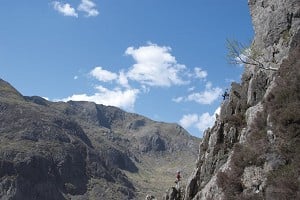
A recent survey by Mountaineering Scotland fielded the climbing community's opinion on a proposed clean-up of old ropes and slings from the top of the Old Man of Hoy in Orkney. The results suggest that 92.5% of respondents are in favour of both a clean-up and replacing the existing abseil bolts.
The announcement of the results and proposed film project about the clean-up sparked a long thread in the UKC Forums, with contrasting opinions on bolting ethics and the motivations behind the survey. We asked forum user and Scottish climber Grant Farquhar, and Hoy climbing guide Sam Percival - the individual who proposed the project - to write two opinion pieces on the subject, while Mountaineering Scotland and filmmaker Christina Shaw also provided statements.
Mountaineering Scotland statement
When Sam Percival approached Mountaineering Scotland about his project to clean up the Old Man of Hoy, we were delighted to hear such an inspiring idea from someone who is clearly passionate about trad climbing, wanted to give something back to the community, and was willing to take on quite an involved project in a voluntary and self-funded capacity.
Mountaineering Scotland offered to facilitate a consultation with the climbing community through an online survey which went live in October 2023 and was open for 2 weeks. This was communicated through our own channels and more widely in the climbing community.
The survey received 937 responses in total. 906 people answered the question about whether they agree with the proposal, of which 846 (93.4%) were positive and 60 (6.6%) responded to say they were not supportive. 457 respondents who agreed with the proposal provided additional comments, 46 comments were submitted by those not in favour of the proposal. A summary of the results was published on the Mountaineering Scotland website in January 2024 (read it here) and the full data set with all of the responses was passed on to Sam for consideration. We are planning to make this available on our website after removing any personal information from the comments to comply with GDPR.
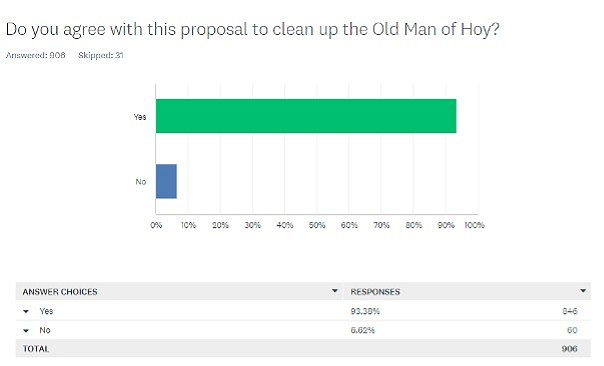
We understand that this project has provoked some strong opinions and much debate, but we believe that Sam has taken a sound approach in consulting with key stakeholders and the climbing community, taking on board their views and making informed decisions about how to proceed. The production of the film and crowdfunding page are separate projects and Mountaineering Scotland is not involved in either initiative.
In relation to the placement of bolts, our policy statement Climbing in Scotland (pdf) continues to provide a point of guidance for the climbing community in Scotland. We continue to support Sam and wish him and his team of volunteers all the best with the project.
Christina Shaw - Filmmaker statement
Dear UKClimbing community,
My name is Christina Shaw and I am the Producer of the documentary about the clean up. Firstly I am not a climber, I am a storyteller and I want to clear up some misconceptions surrounding this film.
It is important to note that the climbers participating in the clean-up, including Sam, are doing so voluntarily, driven by a genuine desire to contribute positively to their community and environment. They are not being paid a penny. They are doing this at their own expense. With some of the gear they need donated by brands.
None of the money raised in this crowd-funder is for the climbers or the proposed clean up.
The film is about much more than old equipment it also has a focus on history, wildlife, the first ascent, interviews, archive footage - amongst many other things.
It may be difficult to see the broader appeal and significance of the proposal beyond climbing interests but this is evident by the articles published by The BBC and The Times. This is also what sparked our interest in making the film.
At a time when the world can feel overwhelmingly negative, it is refreshing to focus on a group of friends who are dedicated to (in their own time) making a difference and taking responsibility in their community.
Producing this kind of film is very expensive, filming in remote places and in an extreme environment is not easy. The amount we are looking for with our crowd-funder is a small fraction of the total cost of this film. Please refer to the crowd-funder which states clearly what contributions will be used for. To put things into perspective, permission to use BBC archive footage costs around £7,000 for just 60 seconds of screen time. We are trying to film this with a micro team so we create as little disturbance on the island as possible.
Regarding funding, like the climbers, both Sue Longden and I are undertaking this project without financial compensation inputting our personal time and resources. Our primary goal is to raise the necessary funds to narrate this story authentically, with profits earmarked for initiatives aimed at enhancing outdoor education and supporting conservation efforts led by organisations such as the RSPB and wildlife charities.
Sam, like many of you, initially questioned the necessity of a documentary and was not easily persuaded. He was concerned it would blur his intentions as this was something that was planned as a group of friends, off camera doing a positive act.
We commend his effort in gathering community input, as evidenced by the survey he initiated with Mountaineering Scotland. He sought permission from the RSPB (landowners) to minimise disruption to protected bird colonies. Additionally, he liaised with The Hoy Trust, representing the local community on the island, as well as Mountain Heritage and engineering professionals. This underscores his genuine intentions and respect for the climbing and wider community.
In response to the diverse array of opinions expressed on forums, we acknowledge and respect differing viewpoints, recognising the value of constructive dialogue. We will invite individuals, both supportive and critical, to share their perspectives on camera, which will create a more inclusive narrative reflective of the broader climbing community. If those I have reached out to, or those who have extensive experience in this dialogue wish to have their views included, please contact me at researchinghoygmail.com
Open letter from Sam Percival
Hello folks, I'm Sam Percival, and I was asked to write some thoughts in response to a UKC forum post that discusses my clean-up project on Hoy. I'm writing this from Bohuslan, on a wet day, waiting for the cracks to dry.
I'm here on a trad climbing holiday. I'm a trad climber at heart. Have been for 20 years.
I love climbing so much, that for a good while, I've tried to do it as a full-time job.
For me, the pinnacle of that has been taking clients to climb the routes I most aspired to climb in my early days, and the Old Man of Hoy ranks high on that list. I feel privileged to have climbed it several times, for personal pleasure and for work.
However, an active life leads sometimes to injury, and injury has made me look at other directions. So as of last September, I began the journey of becoming a paramedic. Now I'm a full-time student, who does a bit of instruction and guiding, and who is looking to give something back in thanks for 20 years of absurd adventure.
A couple of years ago I had the idea that for my 40th, I was going to invite my closest friends to Hoy, supply them with food and beer, and spend two days clearing the many, many rusted nut heads, old cams, and rotten rope from Hoy. For me, it's one of the most adventurous climbing trips you can have in the UK, but one that's marred by gear left in retreat by climbers. Cord, rope, and nuts that have become swollen and stuck in cracks. Rusted, useless, rotting, and all smelling of fish oil.
Removing all this will involve hanging on the stack for a couple of days, with 6 friends helping hammer at the stuck gear, hoisting and dropping down all the rope and tat, and generally making some noise. So, I did what I believe is the right thing; I spoke to the landowners (The RSPB) and asked if that was okay. They drafted an access agreement and gave their full support. I spoke to the Hoy trust, the representative of the local community, and to Hoy Heritage centre. They both said thanks, and crack on.
One aspect of the planned clean-up was troublesome. The Old Man of Hoy was bolted in the 60's and rebolted sometime in the 90's (I've been trying to find out exactly when. If you know, please reach out to me). At best, the abseil bolts are now 25 years old. In conversations I've had with many folks about Hoy, many did not know that the Old Man, a symbol of adventure trad in the UK, has bolted abseil anchors. Maybe it's even a surprise for you reading this, but its true. They are there, they are used by anyone who abseils off it, and they have been there for a very, very long time.
One of the abseil anchors relies on cord tied off to these bolts, and unsurprisingly given the age and environment, they are in a bad way. I can replace the cord connecting them, even back them up with nuts as many climbers sensibly do, but the nuts rot and block the cracks, the wires rust off, and every year, the bolts get a little worse. I believed in seeking another option than kicking this can down the road. I'll be up there, and it would have felt like a job half done if I didn't do something about them.
I've never placed a bolt in my life. But I wondered whether it was time for these to be replaced, like-for-like with modern hardwear. I looked for a thread that could work instead, but I found nothing that wouldn't result in a higher rate of stuck abseil ropes.
Because I was doing some clean-up work and felt it might be time to review the bolts on one of the most cherished routes in the country, I did what I consider to be responsible, I spoke to the Climbing Area Rep for the Highlands and let him know. He advised me what most folks already know; that a like for like replacement is generally accepted. But given the routes profile, suggested I speak to the representative organisation for climbers who live in Scotland, Mountaineering Scotland.
I approached them with my plan for deep cleaning and the idea of putting in something more long term than rope threads; strops, which I was willing to pay for, and asked their opinion. My strop idea was based on the hope that climbers wouldn't feel the need to add more rope to the stack at the threads and I discussed the diameter, material and lifespan with a civil engineer and climber. The lifespan was expected to be 15 years, and I was willing to visit the stack each year and replace them when the time came.
Mountaineering Scotland did something quite novel and progressive, they asked the members and anyone else that had an opinion what they thought. I recognise the criticism of the way it was worded and the anonymity of myself in the survey. I let MS know I wasn't bothered about being anonymous and talked about it openly to anyone I spoke to. The survey was about seeing the opinion of a clean-up, the opinion on strops replacing the old bolts. The route belongs to the climbing community, the stack himself to the RSPB, the area belongs to the locals, and I wanted to make sure they had their say.
I think a lot of confusion about the way it was worded come from a paraphrasing of my conversations with MS, they are a small team and were doing something a little new in this regard. But they were engaging people and trying to gather information using a bigger reach than I have, and I thank them for that. I've been told it was the biggest community response they have ever had.
The responses were interesting. Overwhelmingly positive, reassuring, and progressive and I mean that about the folks that said no too. All opinions are valid, and I want to be guided by the community in this. I agree it was binary in the initial questions, but the free comment box allowed people to express exactly what kind of clean up they wanted and what kind they didn't, and that has shaped the plan from that point on.
I was handed 906 responses about the clean-up, and quantitively; 93.4% of folks responded yes to the proposal, and 6.6% responded no.
Qualitive weighting to those figures suggest 1.2% want no clean up at all. 7.5% want a clean-up without the abseil bolts replaced, and 92.5% want a clean-up with the abseil bolts replaced. I believe MS are working on releasing this information for all to access.
Strops had a following, but not a major one and that's fine with me. I can replace rope just as easily and far more cheaply. Several experienced people came forward offering help and advice about various aspects, and it takes time to have conversations about the best materials, placements, durability, impact, etc. Titanium was one of the obvious changes and has been included. So those talks have been happening in the meantime.
Some folks want the stack never to be climbed again, fair opinion, but that's not going to happen. Some folks want all the original abseil bolts reinstated, and several folks came up with the idea of removing abseil anchors entirely from the climb and moving the descent to another face of the stack. I'd not considered this originally, so planned to head there next month and see if it's even feasible. No point discussing it if it's not. It would solve some issues, but at the expense of others, it's so far removed from the original plan, I'll take it back to the community- if it's even possible.
The stack and the clean-up consultation are important to more than just us as climbers. The locals, the RSPB and anyone with a love for rugged places are invested, I guess that's why the proposal featured on the news. This led the BBC, country-file, and an independent film maker to approach me about a documentary on the history, geography, natural history, and the clean-up. I've done wee bits of film work in the past and really didn't see how a large film crew would fit in with my idea of a small group getting covered in bird poop for my 40th. So, I turned them down. But after a bit of persuasion, I agreed to have the clean-up filmed by some producers utilising a known, independent climbing film company. I thought it would be great to have something to look back on, 85 years old and doddery, that I'd done with my oldest friends. We are not getting paid for it, and it seemed a lot less intrusive, and I was willing to accept the cringe value for having something that would look great to look back on.
The crowdfunding by the film makers has re-sparked debate regarding the clean-up, a commercial aspect, an increase in traffic, a reduction in adventure value, a sanitising of the climb, the concern that this is a thin end of a wedge, the figures from the consultation and most controversially, the replacement of the rotten bolts. All reasonable, and apologies for not responding in the forum- I'm not really a forum person. Additionally, because of the number of folks with an opinion, it would be challenging to discuss developments one on one… with everyone! The decisions made are about more than one opinion, they are about the majority, not about the individual that shouts the loudest. So, always engaging with individuals doesn't help develop the narrative. Hopefully what you have read so far will help you understand what the process has been and why, but below I'll try to respond to the general themes in the forum specifically.
So, regards a clean-up, yep, that's going ahead, we intend to visit after the seabirds have left in the autumn. By 'clean-up' I refer to clearing the cracks, and removing the rotten rope, if anyone wants to remove some of this ahead of us, great. It will save us a lot of work, but please do speak to the RSPB first as they are keen to keep disturbance to a minimum.
Regards a commercial aspect, there's no subterfuge here, any folks who know me know I guide climbs, and I probably climbed the Old Man more than anyone last year; four ascents. It will be three ascents this year, besides the clean-up. I love helping people access that lump, it's amazing to share that experience. But as I step away from instruction towards paramedicine, this will be less. I'm not sure how I'd make it commercially successful, even if I wanted to. I'd get bored doing the same route, and not that many people want to climb it. I'm more bothered about making it a nice experience for those that do. Guided and unguided alike.
An increase in traffic is possible I guess, same as after Bonington's and Houlding's, and Jesse's ascents. But it's a long way for people to go, and there is a skill barrier to access the route. That's likely to limit numbers to a couple of extra ascents for the next couple of years. I hope those people have a great time. It's an ace adventure.
It's hard to speak about the reduction in adventure value without pure opinion, how do you quantify adventure? I'm intending to make the climb harder, less stuck gear and fewer belays to clip. I'm not changing the length of the drive North, the first sight of the stack from the ferry, the anxiety about the weather, or the state of the bothy. I intend to remove two intermediate fixed and rotten belays entirely. I want it to be a purer trad route than it already is. I want it to feel more like you are the first (well, second, I'm leaving the wooden chocks.) person to climb it. It's a real shame the abseil comes down the same way as the classic route, as this does remove some of that feeling, but you can always climb a harder line, and even if you don't, the Original Route will still be cleaner in ascent.
Sanitising of the climb, well, see above. The abseil could be seen as being sanitised if all anchors were replaced by bolts, But I'm the one headed up in the autumn and I'm not doing that, even if the community decide they want a separate abseil line or all the abseil bolts reinstated, it'll be someone else that marches that flag forward.
The abseil that is bolted now was 'sanitised', then 'sanitised' again when it was re-bolted. Those bolts are now way past their use by date (see pictures) and are overdue replacement, the amount of rusted nut heads in cracks that have been used to back them up help demonstrate this point. So, one of the abseils will be returned to a state that the adventure has been in previously, and we'll be back to a situation where climbers don't have to discard gear here to rot away. I struggle to associate this with the word sanitising.
The thin end of the wedge. Well, if it is, I'm certainly not the whole wedge. This has involved two years of talks, a lot of time and effort, some personal cash, and some character assassination online. It's an offer of labour to the community, an attempt to find out what they want, and the intention to maintain the quality of the stack while I still live in the Highlands (and still live generally). The consultation showed that most climbers want progressive change. But I'm not the one to champion it. I'm not pretty or famous enough! I just helped find out. This is why we have governing bodies and I invite them to lead the tough, long term change discussions. I'll be hiding behind the sandbags.
The numbers from the consultation are above and were posted on the MS website too. The comments make me smile; it's reassuring to be reminded that climbers are a good bunch generally. Hopefully the comments will become accessible for all, I'd like that to be the case. But either way, MS are friendly and approachable, if you have any questions, drop them an email.
Finally, the controversial replacement of the worn-out bolts. This has involved conversations with experienced bolters, bolt manufacturers, the RSBP, Mountaineering Scotland, peers, old-school, and progressive climbers and most importantly; you. The community. The community responded with a huge majority for the replacement of the worn-out bolts for Titanium bolts. I'm having these specifically made for the job and the environment, and looking to have them placed by someone with the credentials worthy of doing it on hallowed ground.
A small number of people have encouraged the idea that the abseil is being bolted for the first time, or that the whole climbing route is being retro bolted. If you believe this currently, I'm leading this and I'm telling you none of those things are true. It just sounds controversial, and that makes good forum chatter. Don't fall for it.
I believe the way forward for British climbing is to consult, but I'm not naive enough to think that unanimous, logical agreement is likely. Climbing isn't based in logic; it's based in emotion. It's not about what, where or how you climb, it's about how it makes you feel.
I'm also an old(ish) bald, white man who doesn't believe climbing should be decided by old(ish!) bald, white men alone. Climbers are more diverse than ever, and the direction and opinions are as diverse too. Decisions must lie with the landowners, the locals, and the greater climbing community. The comments that express thanks at the offer of the volunteer work or thank MS for the consultation are overwhelming and reassuring. I hold on to that when I'm feeling like just sacking the whole thing off.
Sticking my head up above the parapet was always going to attract attention, some distrust, and some slander. Climbers are human after all, and I was (mostly) prepared for it. I try to smile, and do the right thing, and remember the numbers show that this comes from a small minority. I've received criticism on the forum and if I'm entitled to just one criticism in return, it's that when I read through it, I observe individuals informing us of their opinion, and telling why it is the most valid, but without them asking what your opinion is in return.
Cracks should be dry by now…
Thanks,
Sam
Opinion piece by Grant Farquhar - Scottish climber snd UKC User
Now is no time to think of what you do not have. Think of what you can do with what there is.
Ernest Hemingway, The Old Man and the Sea.
The proposed 'clean up' of The Old Man of Hoy sounds like a good idea doesn't it?
Superficially, yes, but there is more to this story than initially meets the eye, and the plan to place titanium glue-in bolts on belays for descent, perhaps on a separate 'abseil piste' from the Original Route, would make for a radical change of ethical climbing practices and set a precedent that would take trad climbing on UK sea cliffs down a different path from what it has previously been on. As someone said in a forum thread about retrobolting: 'Look further down the road, not just at what is in front of you.'
So, let's take a look at what has been happening. The Old Man of Hoy is an iconic sea stack on Orkney and is emblematic of the type of adventurous trad climbing to be found on sea cliffs in the UK. It is literally the poster child for such climbing, and people come from around the world to climb it. The first ascent was made by Rusty Baillie, Tom Patey and Chris Bonington in 1966, and is currently graded E1 5b. Chris Bonington wrote in Hard Rock: 'The Old Man of Hoy is undoubtedly Britain's finest sea stack; it can probably also claim to be Britain's most rewarding summit.' This remains true today. In the 50+ years since the first ascent, it has probably had thousands of ascents, with 807 ascents currently logged on UKC alone.
Those ascents, and abseil descents, have so far relied on the in situ fixed gear on the Old Man, which mostly consists of metalwork (pegs, ancient bolts) and nylon threads and has been, so far, regarded as safe. However, concerns have recently been raised that the proliferation of threads (tat) that inevitably accumulates in such locations (as climbers add more without removing the old tat) is aesthetically unsightly and environmentally unfriendly—as well as being unsafe for climbing purposes.
In October 2023, Mountaineering Scotland sought opinions on a proposed project to clean up The Old Man of Hoy with the stated aims of 'removing and disposing of all the rotting climbing rubbish from the stack', and to 'make abseil stations safer and ensure no old gear is required to abseil off.' All of this was to be done 'in a voluntary capacity at their own cost and time, with the full support of the landowner' (the RSPB). The identity of the proposer/volunteer was not disclosed.
The consultation took the form of an online survey. Mountaineering Scotland is the only recognised representative organisation for hill walkers, climbers, mountaineers and ski-tourers in Scotland. Their stated positions on climbing ethics and caring for the environment can be found on their website and include the following on avoiding leaving 'visually intrusive climbing 'litter'':
'The use of hammer-placed protection is agreed to be a last resort and should be avoided wherever possible... Local climbers (or the first ascensionists) endeavour on an ad-hoc basis to replace in-situ 'traditional' protection (pegs, nuts, slings and threads) when they degrade, but often pegs and nuts cannot be replaced. The natural progression towards a 'pure ascent' of a climb without older in-situ protection is a recommended ethic in adventure climbing... Bolts are unacceptable to the majority of Scottish climbers on established (documented) mountain cliffs and sea cliffs, in both summer and winter... Established (documented) 'traditional' and sport venues would be expected to remain in their documented style. If a change in style is to be considered in the future (bearing in mind the above guideline on mountain and sea cliff venues) then generally:
Retro-bolting (the addition of bolts to established climbs without them) would only be considered with the agreement of the first ascensionist and after wide consultation with interested climbers at local and national level.'
So far, so good.
The results of the survey were duly published on the Mountaineering Scotland website in January 2024, stating that the survey 'produced an amazing response with 962 comments on the proposals as well as attracting media interest from Sky News, the BBC and The Times.' Mountaineering Scotland also stated: 'We were able to support the volunteer leading this project and provide a platform for the community to express their views on this topic'.
Although, once again, the identity of the volunteer was not disclosed.
The results of the consultation were summarised as follows:
Overwhelmingly, you were supportive of the aim to remove the old and unsightly tat that had been left behind by decades of climbers. There was some frustration expressed as to why climbers couldn't, or wouldn't, take old gear away with them and leave litter behind when they were able to.
- There was a clear majority view in favour of moving to a more long-term and low-impact solution for abseil stations and belays - being more sustainable without becoming a sanitised experience; not over-developing the rock and retaining the sense of history and adventure.
- There were mixed views on what this should be, but generally to look at options other than bolts, where it is possible; tending toward like-for-like replacement with modern alternative options - to provide longer term security of ascent and descent without reliance on old and decaying gear.
- The cultural and historical aspects of some of the gear was mentioned with a plea to retain cultural artefacts to give a sense of the history of the ascent. Care will be taken to differentiate between significant historical gear and old stuff that has been left behind, with significant cultural items remaining.
- There were of course views expressed that the rock should be cleared, and left as a natural trad adventure climb as much as possible, relying on the climbing community to police itself and remove old decaying gear. This has been the model for past decades. The current state of the stack suggests that this approach will produce the same result in the near future.
So what happened next?
A crowdfunder titled 'Backing Beauty: Documenting Hoy's Restoration' was posted on the internet setting a target to reach of £35k by 30 May in order to fund 'a captivating documentary about climbers restoring The Old Man of Hoy, showcasing environmental stewardship in action.'
'The crowdfunder page revealed the identity of the proposers/volunteers behind the project: 'The film follows Sam Percival (WMCI), a climbing guide who runs . He is an experienced climber and a member of the Association of Mountaineering Instructors. Sam, along with a group of six close friends, proposed a detailed plan to clean up the stack and implement more sustainable descent solutions. The proposal received a huge response from the British climbing community, and resulted in comprehensive discussions regarding ethics, stewardship and sustainability.
"The vast majority of the UK climbing community is behind the project, but climbing ethics are complex, and the film will explore how the team maintains an important sense of adventure, balanced against social and environmental responsibility. Sam regularly guides on Hoy, and has witnessed an ever-growing amount of gear left behind, but a decrease in the quality of the essential anchors, prompting him to take action. At their own cost Sam's team aims to create a safer, more sustainable climb and most importantly give some much needed care to "The Old Man" who has been so badly neglected. The project sets clear objectives, including the removal of old climbing gear and the implementation of sustainable and discreet abseil solutions."
Mr Percival also posted on Facebook: 'We made adjustments to the clean up and refit plan. The original plan was strops, but because they are unfamiliar to most climbers, hard to assess and have a relatively short lifespan they have been deemed inappropriate. The vast majority of the community; (reassuringly 90%+) are happy with titanium bolts for descent only. It is a stack after all, abseil is the only way off. We are assessing a route for a separate abseil line this summer which will be away from the original trad route.'
It's not clear where the '90%+" in favour of bolts figure comes from, as a detailed breakdown of the Mountaineering Scotland survey was not published, but the figure seems to be at odds with the summary of the survey: 'There were mixed views on what this should be, but generally to look at options other than bolts.'
And the plan (apart from using titanium) appears to be similar to the one proposed prior to the consultation, with the addition of a separate abseil line, or 'piste' for descent. By the way, the crowdfunder has so far raised £355, so whether the proposed filming of the clean up goes ahead is in question.
So what's the beef?
The most contentious issue is the proposed use of modern titanium glue-in bolts on a historic, famous trad sea cliff that has had thousands of ascents without and the implications of such an act for the future direction of sea cliff climbing in Britain. This issue has cropped up on other UK crags in recent years, notably Gogarth, where bolted abseil stations have been repeatedly proposed (and mostly rejected) and the appearance of so-called 'peg-bolts'. Please refer to the cat in the picture for my opinion on whether these are pegs or bolts.
These were placed without consultation and have been extensively debated on UKC, but as far as I'm aware, they remain in situ on the crag.
Abseil bolts also appeared on Diabaig, about which Mountaineering Scotland conducted a survey and issued a statement:
"Our online survey received 452 responses, with a decisive majority of 74% upholding the view set out in the current climbing guidelines that the placement of bolts at Diabaig would not be supported.'
As far as I'm aware, those bolts remain in situ too.
When bolts were first introduced in Scotland in the 1980s, the Mountaneering Council of Scotland (the earlier incarnation of Mountaineering Scotland) devised a set of guidelines which, although vague, did attempt to set some limits on the use of bolts. Nevertheless, bolting has continued. Scottish Sport Climbs, published in 2013, described over 1,300 sport climbs in Scotland at that point (and I have it on good authority that the number of sport climbs in Scotland, now, is approaching double that figure). Convenience bolts have also appeared (e.g. at Diabaig) and no doubt bolts will continue to proliferate in Scotland.
This contrasts with the situation in Pembroke and Cornwall, where a clear line was drawn: no bolts. This was at the expense of existing bolted routes (e.g. at Carn Vellan) that were therefore 'sacrificed' for the greater good of preserving the trad ethic in those areas. This position of drawing a clear line has been successful in that these areas remain unambiguously and uniquely trad climbing areas, with pretty much no sport routes or bolts appearing on trad routes for various reasons.
Scotland, therefore, has trad and sport climbing, with the latter mostly occurring on designated sport crags or sport areas on sections of traditionally trad crags (e.g. at Dunkeld, Creag a' Bhancair and Loch Maree Crag). Retrobolting the Old Man of Hoy would be a significant departure from the current framework.
Where might bolts on trad crags be acceptable, then?
The arguments for bolts being justified in specific cases on otherwise trad cliffs logically fall into certain categories. Let's scrutinise how these arguments apply to the Old Man.
- Historical - A historical argument says that the presence of pre-existing, usually ancient, metalwork on the crag justifies upgrading and replacement with modern equivalents. The Old Man does, indeed, have such metalwork on it—relics from the age before modem protection. This is the primary argument in favour of the peg-bolts on Gogarth, as modern equipment rendered the old pegs obsolete or the routes were simply climbed without them at a higher grade. It's debatable whether the presence of such ancient ironmongery on the Old Man justifies replacement with modem equivalents. It's definitely not necessary on belays on the way up. But on the way down, something has to be left in situ. What this consists of depends on what is available—trad gear and/or natural features such as threads and spikes. Modern bolts have not been considered necessary up to now. What has changed?
- Convenience - An argument that bolts improve the experience by saving time. Notably, and highly relevant to the current proposal, this category includes 'commercial' bolting i.e. bolts placed to facilitate guiding of routes. Trad belays can be time-consuming to build (the bolt placed, and still in situ, at the top of Rhoscolyn is a good example) or the walk off is tedious (the Diabaig bolts). But personally, I don't choose to go climbing for convenience, especially when trad climbing. For me, and likely many others, convenience increases the ticks, but dilutes the experience.
- Safety - There is an argument that modem bolts are more reliable than old metalwork or trad gear. This is generally true, but the crag is not a climbing gym, and the existing route is perfectly safe to ascend and descend as it is. I would be surprised if there have not been any accidents or fatalities on The Old Man, as climbing is inherently dangerous and plenty of accidents also occur on sport crags and climbing gyms. However, I doubt that there have been any accidents as a result of belay failure and I, for one, had no more than the usual concerns about safety in trad climbing when abseiling down the Old Man after climbing it, which seemed like a normal, unremarkable descent that is typically found on sea cliffs in the UK. It's important to point out that the Old Man can be descended in 2 x 60m abseils, and both of those anchors are natural, can be made with rope without relying on any in situ metalwork, and a titanium chain could be installed, if deemed necessary, without any drilling for bolts required.
- Aesthetic - Some argue that in situ tat looks unsightly compared to bolts, which are harder to spot. Mountaineering Scotland does mention avoiding 'visually intrusive climbing litter' in their guidelines. This has some merit, but is an opinion rather than an argument. Some people hate the tat, some don't care. Some find bolts and chains more unsightly than tat. However, it's only really an issue when you are on the route, as you would be struggling to see any tat or in situ metalwork on the Old Man from the neighbouring headland. It's worth mentioning that even if titanium bolts are placed, tat will once again proliferate as climbers add their own backups to the in situ metalwork on descent, especially once it starts showing signs of wear, which it inevitably will.
- Environmental - It could be said that ancient metalwork and tat is 'litter' that is harmful to the environment in unspecified ways. The Hoy Crowdfunder page states: 'Old gear is not only making it difficult for climbers, but it also affects the homes of beautiful nesting sea birds such as Puffins, Fulmars and the Great Skua.' It's not specified exactly how the in situ gear does this, but it's worth bearing in mind that the landowner of The Old Man of Hoy is the RSPB and considering the often fractious relationship between climbers and ornithologists, the most logical thing for the RSPB to do would be to simply ban climbing if it is affecting the birds. Seasonal bird bans exist on many sea cliffs in the UK, and I would argue that climbers present on the cliff will have a much larger impact than any in situ gear. It's also been pointed out that the environmental footprint of travelling to Hoy to climb the Old Man has an environmental impact that dwarfs any such potential impact from the in situ gear and increasing the popularity of the route by making it more accessible—or dumbed down—through bolted belays will only increase this.
- Popularity - A common argument for (retro)bolting is that certain routes are not getting enough traffic and becoming vegetated because the metalwork has corroded, so no one wants to climb them. This is the secondary argument for the peg-bolts on Gogarth. This one doesn't apply to the Old Man, as it's already a very popular route that most competent climbers have no problem with.
When you read online forum threads like the UKC ones, people are often rehashing arguments which fall into one of these categories, or they are attempting to rebut an argument from one category with an answer from a different category. These threads are interminable and not a pleasure to read. For me, the biggest issue with making exceptional case-by-case arguments for when bolts are justified in trad areas is: where does it stop?
Remember: look down the road, not just at what is in front of you. When you make a case for placing bolts in a certain route or belay on the basis of one of the categories above, it may seem logical, and you might be convinced that it is the right thing to do for that route. But it only strengthens the case for more bolting, or sanitisation, of the crags further down the road.
Of course, many people don't care about preserving the ethics of trad climbing and will accuse me of being an old man whose opinion is obsolete, but if we accept the arguments for bolted belays on the Old Man, then surely bolted belays on other sea stacks and sea cliffs will follow as the same arguments apply to them.
I, personally, would much prefer to see British sea cliffs like the Old Man remain the wild, adventurous places they are without having that adventurous nature diluted and sanitised by bolting. Our historical climbing ethics have made our crags internationally unique and renowned. The type of wild, adventurous trad climbing found on British sea cliffs gives us something rare that nourishes our soul. This type of climbing needs to be preserved and celebrated, not tamed.
So, where to next?
I don't know, and it's not my call—it is one for the consensus of the wider climbing community. But, first of all, Mr Percival and his team should be applauded for their willingness to volunteer to clean up the Old Man and remove the accumulated tat. As should Mountaineering Scotland for their consultation process and for conducting a survey of climbers' opinions on the issue—unlike the situation on Gogarth, at least we are having a debate before action is taken. However, I'm concerned that the bolting of the Old Man appears to be going ahead this summer following an arguably flawed consultation process.
Mountaineering Scotland did not disclose that the individuals behind this proposal could be seen to have a financial conflict of interest, in that they are involved with a company that offers commercially guided trips up the Old Man and therefore stand to benefit from the installation of bolts which will make such ascents easier and potentially more attractive to customers. The proposed 'abseil piste' is presented with the purported noble intention of keeping bolts off the Original Route itself, but would presumably facilitate guided ascents by reducing traffic on The Original Route if a separate abseil descent is used and the belays do not have to be shared. Additionally, a separate 'abseil piste' would presumably encroach on other existing or potential new routes routes on the stack.
This raises the question of whether the survey is valid. Although Mountaineering Scotland knew the identity of the proposers, they did not disclose it, which may well have altered the findings if they had done so due to the perceived conflict of interest. It would also be good for transparency to see the results in more detail than a summary in order to ascertain where the '90%+' in favour of bolts comes from.
So while I don't know the best way forward, my concerns are that this retrobolting 'clean up' proposal has been presented primarily on safety and, arguably greenwashing, environmental grounds, but appears mainly to be a case for convenience bolting from proposers who could be seen to have a commercial conflict of interest, and that bolting the Old Man appears contrary to Mountaineering Scotland's own published position on bolts in Scotland. Above all, they are simply not necessary: you can descend in two abseils and a titanium chain (without drilling) on those belays would assuage concerns if they are genuinely safety and environmental rather than convenience (or commercial) concerns.
Climbing is about adventure. Surely we don't seek or want sanitisation of our adventures? Why go to McDonalds when you can have cordon bleu? If my thesis seems extreme, then please bear in mind that, from my perspective, I am being reasonable. I could make a much stronger case for no bolts on the Old Man, but then I might come across as not only an old man, but also a c-word. You have probably gathered that I have a strong personal opinion on this matter, but I am only one voice. I would happily accept the consensus opinion of the climbing community as to what is best for the Old Man and sea cliff climbing in general in the UK, providing this has been properly consulted and decided upon.
And, finally, the views of the surviving first ascensionists, Rusty Baillie and Chris Bonington, should be solicited and considered before moving forwards—I would be surprised if they placed any bolts on the first ascent. If they didn't need them in 1966, why do we need them now?

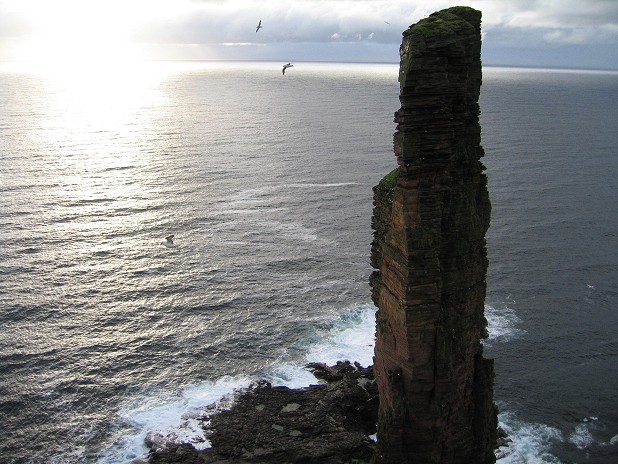


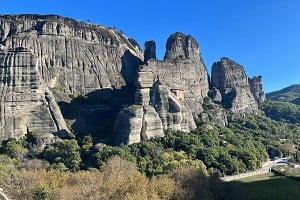

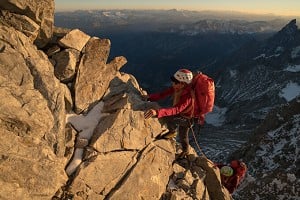









Comments
Thanks UKC for making the survey results available, and for obtaining this statement from Sam. There are two major issues with the whole thing.
Although MS tried to help, unfortunately the consultation questionnaire was really poor. They started by setting out their own position of being in favour of the clean-up. A lot of info was given about possible advantages, with no reference to possible disadvantages. There was not even a "Why? / Explain your position" question. All of the above bias made the whole process deeply flawed. A real pity, as it would have been interesting to know how the climbing community felt about the proposal, if only one could have any confidence in the results.
Secondly, what results there are seem to have been mis-interpreted. After a really poorly designed consultation, over 90% were in favour of a clean-up. Sam did not make clear that the proposal was specifically for new bolts. Given this was not made clear, it's disingenuous at best to suggest that over 90% are in favour of bolts. Quite simply, the question was not asked.
Absolutely agree. The MS survey was so poorly done that the results, or at least how they are reported is completely inaccurate. Of course the majority of climbers agree with a clean up.. but 93.4% weren't in favour of retro bolting the belays/abseil points.
Thank you for submitting a summary Sam, but I have to admit it's a little ambiguous as you say that you will look at whether a separate abseil line is possible/feasible, and then near the end indicate that you won't be putting in a separate abseil line despite looking into it's feasibility! So which is it?
I'm still not sure what you propose to bolt, you sort of say you are replacing bolts then say you aren't but I probably need to re-read your statement! Sorry Sam but to me you give conflicting information in your post about what you are actually going to do aside from taking out all of the old rope/slings/software (which is positive).
What a mess MS made of the whole thing.
The badly flawed consultation, if anything can be concluded at all, seems to suggests that there is a clear desire for the tat to to cleared up but preferably not at the expense of having bolts. It is not obvious what the way forward is from that.
Given that this could lead to an important departure from MS's own bolting guidelines and a potentially far reaching precedent being set, I would have thought it obvious that MS should start again and have a properly thought out and fully transparent consultation; something like this really ought to be done right.
Seemed to me that Sam was pretty clear that he will not be installing any new hardware on the stack. He's going there to clean out the existing rotten tat and look at whether an alternate abseil line is actually possible so it can be a better-informed debate, not necessarily saying that he thinks that is the best option.
Personally I agree with Sam that a lot of the noise around the plan is a bit silly - why should a set of new, safer bolts take away from the adventure of the place any more than the old bolts that are already there? As he says, it has already been 'sanitised', so I don't really think that it sets any kind of new precedent for Scottish sea cliffs to replace them with something simpler and safer. Can you really 'retro bolt' a route that has already been retro-bolted twice?
He mentions getting someone else to put in titanium bolts? That's why I got a bit lost in his statement. It was good to have it, but I found it contradictory, but I am a bit autistic, so maybe that's why I struggled with it (I need something to be clearly stated - which this isn't)!?
(still personally don't understand why you'd look if a separate abseil line is feasible if not doing it.. it just adds to the annoyance to a lot of climbers as this shouldn't even be considered).
Thanks for answering Brendan, I just want a clear idea of what the F is going on with it :-)